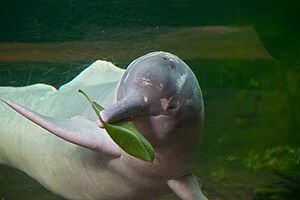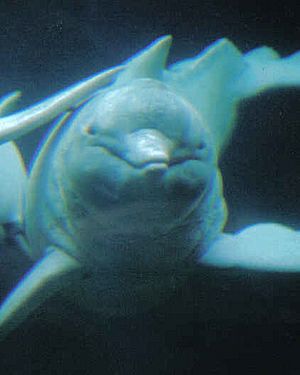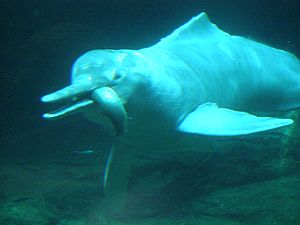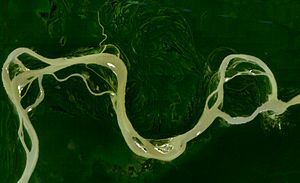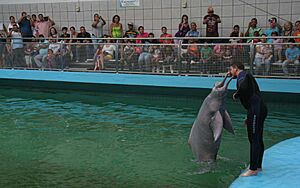Amazon river dolphin facts for kids
Quick facts for kids Amazon river dolphin |
|
|---|---|
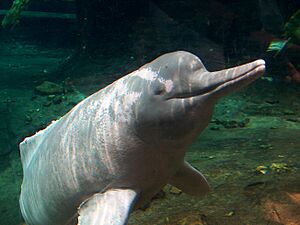 |
|
 |
|
| Size compared to an average human | |
| Conservation status | |
| Scientific classification | |
| Genus: |
Inia
|
| Species: |
geoffrensis
|
 |
|
| Amazon river dolphin range | |
The Amazon river dolphin (Inia geoffrensis), also known as the boto, bufeo or pink river dolphin, is a special type of toothed whale. It lives only in South America. This amazing animal belongs to a family called Iniidae.
There are three main groups, or subspecies, of this dolphin. These are the Amazon river dolphin, the Bolivian river dolphin, and the Orinoco river dolphin. They live in different parts of the Amazon basin and the Orinoco basin.
The Amazon river dolphin is the biggest river dolphin. Adult males can weigh up to 185 kilograms (408 lb) and be 2.5 metres (8.2 ft) long. As they get older, they turn pink, especially the males. This is why they are often called "pink river dolphins." Males are usually bigger than females.
Like other toothed whales, they have a special organ called a melon. They use this for biosonar, which is like a built-in radar system. Their fins are large, and their backbones are not fused together. This helps them move easily through flooded forests to catch food.
These dolphins eat many different things. They can eat up to 53 kinds of fish, like catfish and piranhas. They also enjoy snacks like river turtles, frogs, and freshwater crabs.
Sadly, in 2018, the Amazon river dolphin was listed as an endangered animal. Their numbers are going down. They face dangers like getting caught in fishing nets. Sometimes, they are hunted for fish bait or to stop them from eating fish. Dams and pollution also hurt them. Losing their natural home is a big problem too.
It is very rare to see this type of river dolphin in zoos. They are hard to train, and many do not live long in captivity.
Contents
What is a Pink River Dolphin?
The Amazon river dolphin is a unique mammal. It was first described in 1817. Scientists have studied how these dolphins are related to other dolphins. They are now grouped in a special family called Inioidea.
Scientists are still debating how to classify these dolphins. Some recognize two subspecies. These are the Amazon river dolphin and the Bolivian river dolphin. A third group, the Orinoco river dolphin, is also sometimes mentioned. However, some studies suggest they are very similar to the Amazon river dolphin.
The Bolivian river dolphin is often considered a separate subspecies. It lives in the upper parts of the Madeira River in Bolivia. Other studies have looked at a third species in the Araguaia-Tocantins basin. But this is not yet officially recognized by major groups.
Different Types of Pink River Dolphins

- Inia geoffrensis geoffrensis: This group lives in most of the Amazon River. This includes rivers like the Tocantins and Madeira. They can also be found in the Rio Negro and into the Orinoco River through the Casiquiare canal.
- Inia geoffrensis boliviensis: These dolphins live in the higher parts of the Madeira River in Bolivia. They are found in the Mamore River and its main branch, the Iténez.
- Inia geoffrensis humboldtiana: These dolphins are found in the Orinoco River basin. This includes the Apure and Meta rivers. However, many scientists do not officially recognize this as a separate subspecies.
How Do Pink River Dolphins Look?
The Amazon river dolphin is the biggest river dolphin. Adult males can be up to 2.55 metres (8.4 ft) long. They can weigh up to 185 kilograms (408 lb). Females are a bit smaller. They reach about 2.15 metres (7.1 ft) long and weigh around 150 kilograms (330 lb).
Their bodies are strong and flexible. Unlike ocean dolphins, their neck bones are not joined. This means they can turn their heads up to 90 degrees! Their tail fins are wide and shaped like triangles. They have a short but long fin on their back. Their front fins are large and shaped like paddles. These big fins help them move very well through the flooded forest, even if it makes them a bit slower.
Their color changes as they grow. Babies are dark grey. Young dolphins become light grey. Adults turn pink. This pink color comes from their skin rubbing. Males are often pinker than females. This is because they get more scratches from fighting with other dolphins. The color can also change based on water temperature and how clear the water is.
Their skull is a bit uneven. They have a long, thin snout with many teeth. They have different kinds of teeth for grabbing and crushing their food. Even though their eyes are small, they can see well both in and out of the water. They have a melon on their head. They can change its shape to help with their biosonar. They usually breathe every 30 to 110 seconds.
How Long Do They Live?
We don't know exactly how long Amazon river dolphins live in the wild. But in zoos, healthy ones have lived for 10 to 30 years. One dolphin named Baby, at the Duisburg Zoo in Germany, lived for over 46 years!
Life and Habits of Pink River Dolphins
Amazon river dolphins are usually seen alone or in pairs. Sometimes, they gather in groups of up to eight. In the Amazon, groups as large as 37 have been seen, but three is more common. When there's lots of food, many dolphins might gather. This is especially true where rivers meet.
During the rainy season, males often stay in the main river channels. Females and their young go into the flooded areas. This might protect the young from male aggression. In the dry season, they mix more. They are top predators in their freshwater homes. Their gatherings depend on where the food and good habitats are.
Dolphins in zoos have shown they are curious. They are not very afraid of new things. In the wild, they have been seen playing with sticks, logs, and even turtles! They might also rub against boats.
They are slow swimmers, usually moving at 1.5 to 3.2 kilometres per hour (0.93 to 1.99 mph). But they can swim faster, up to 14 to 22 kilometres per hour (8.7 to 13.7 mph). When they come up for air, their snout, melon, and back fin appear at the same time. They rarely show their tail before diving. They can also jump out of the water, sometimes as high as a meter.
Having Babies
Pink river dolphins usually have their babies between May and June. This is when the rivers flood. Staying in flooded areas helps mothers and their young. As water levels drop, food becomes easier to find. This gives the babies enough energy to grow.
Pregnancy lasts about eleven months. Births in captivity take 4 to 5 hours. Newborns are about 80 centimetres (31 in) long. They grow about 0.21 metres (0.69 ft) each year. Mothers nurse their calves for about a year. Young dolphins become independent after two to three years.
Mothers spend a long time caring for their young. This helps the young dolphins learn and grow. Most pairs seen in the wild are a mother and her calf.
What Do They Eat?
The Amazon river dolphin has the most varied diet of all toothed whales. They eat at least 53 different kinds of fish. The fish they eat are usually between 5 and 80 centimetres (2.0 and 31.5 in) long. They often eat fish like croakers, cichlids, and piranhas. Their strong teeth also let them eat river turtles and freshwater crabs.
Their diet changes with the seasons. In the wet season, fish are spread out, so it's harder to catch them. In the dry season, fish are more concentrated, so they can be pickier.
These dolphins often feed throughout the day and night. They eat about 5.5% of their body weight daily. Sometimes, they use disturbances made by boats to catch confused fish. They also hunt with other animals like tucuxi dolphins and giant otters. They work together to catch fish. They don't compete much for food because they prefer different prey.
Using Sound to See (Echolocation)
Amazonian rivers are often very cloudy. So, Amazon river dolphins rely a lot on their echolocation to find their way and hunt. Echolocation is like using sound waves to create a picture of their surroundings. They send out clicks and listen for the echoes.
In murky water, they make clicking noises, 30 to 80 times per second. By listening to the echoes, they can find their prey. They make less powerful clicks than other dolphins. This helps them focus on nearby objects and avoid too many confusing echoes. This allows them to click quickly and get a fast update on their surroundings.
How They Communicate
Like other dolphins, river dolphins use whistling sounds to talk to each other. These sounds seem to be linked to when they come to the surface before diving. This might mean they use them when looking for food. Their calls sound different from the usual whistles of other dolphin species.
Where Do Pink River Dolphins Live?
Amazon river dolphins are the most widespread river dolphins. They live in six South American countries: Bolivia, Brazil, Colombia, Ecuador, Peru, and Venezuela. This area covers about 7 million square kilometres (2.7 million square miles). Waterfalls and very shallow water limit where they can go.
They also live in the Orinoco River basin. The only connection between the Orinoco and the Amazon is the Casiquiare canal. Their location changes with the seasons. In the dry season, they stay in the main river beds. In the rainy season, when rivers overflow, they spread out into flooded forests and plains.
It's hard to count how many there are because of different counting methods. But studies suggest that Amazon river dolphins live in higher numbers than any other cetacean (whales, dolphins, and porpoises).
Their Home and Movements
The Amazon river dolphin lives in most water habitats in its area. This includes big rivers, smaller channels, lakes, and even at the ends of waterfalls. Water levels change a lot throughout the year. During the dry season, dolphins stay in the main river channels. In the rainy season, they move into smaller rivers and flooded forests.
Males and females seem to prefer different places. Males return to the main rivers when water levels are high. Females and their young stay in flooded areas as long as possible. This might protect the young from male dolphins and other predators.
Scientists use photos to identify individual dolphins. They look at their skin patterns, scars, and snout shapes. This helps them track how far dolphins travel. Some dolphins have been seen moving up to 220 kilometres (140 mi).
Pink River Dolphins and People
In Zoos
In the past, many Amazon river dolphins were kept in dolphinariums. Today, only one is known to be in captivity, at Zoologico de Quistochoca in Peru. Hundreds were caught between the 1950s and 1970s. But most of them did not survive long in captivity. The last one in a US zoo died in 2002.
Dangers They Face
The Amazon region is huge and has many important ecosystems. One is the floodplain, or várzea forest. This forest is home to many fish that people eat. It's also a big source of income for local fishermen. The várzea has muddy waters rich in different kinds of fish. This attracts both dolphins and fishermen.
Human fishing activities compete with the dolphins for the same fish. This can lead to dolphins getting caught in nets by accident. Sometimes, fishermen deliberately kill dolphins. This happens if dolphins damage their nets or eat their catch. Fishermen can get angry because they are not paid for the damage.
Mercury from mining and other chemicals pollute the Amazon River. This is very dangerous for all animals in the river, including dolphins. Studies have found high levels of mercury in some pink dolphins.
In September 2023, many Amazon river dolphins died in Brazil's Lake Tefé. This happened because of very hot water and low water levels during a drought. Scientists think the heat caused algae to release a toxin. This toxin might have attacked the dolphins' nervous systems.
How We Can Help Them
In 2008, the International Whaling Commission (IWC) worried about dolphins being caught for bait. This was becoming a big problem. The species is listed in Appendix II of CITES. This means it needs international help to protect it.
Scientists once thought the dolphin population was large and stable. But now, human actions are causing their numbers to drop. Experts have suggested ways to help. These include studying their populations and tracking where they live. It's also important to learn more about fishing and pollution threats.
In 2012, Bolivia's President Evo Morales made a law to protect the dolphin. He declared it a national treasure.
In 2018, the species was added to the Red List of endangered species.
Pollution and the destruction of the Amazon rainforest make these dolphins even more vulnerable. It is also very hard to keep these animals alive in captivity. This means breeding them in zoos is not a good way to save them.
The Global Declaration for River Dolphins aims to help all river dolphin populations. As of early 2024, many countries with river dolphins have signed this declaration.
Gallery
See also
 In Spanish: Delfín rosado para niños
In Spanish: Delfín rosado para niños
- Unihemispheric slow-wave sleep
- List of cetaceans
- Porpoise
- Dolphin
- Dolphinarium
- Pacific Ocean
- Atlantic Ocean
- Boto




